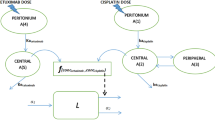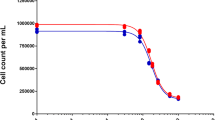Summary
In in vitro testing, no pharmacologic synergism has been found for the combination of cisplatin and etoposide in P388 leukemia in contrast to the demonstration of therapeutic synergism in the same model. No pharmacologic synergism has been found for the same combination in the treatment of four small-cell lung-cancer cell lines, although clinical results obtained using this combination in small-cell lung cancer and other cancers suggest a therapeutic advantage. The popular concept of synergy, implying a therapeutic advantage, is different from the pharmacologic meaning, which generally implies that less drug is required in a combination for an equal effect. Therapeutic advantage may be obtained regardless of whether drugs are synergistic in the pharmacologic sense in the treatment of a tumor. To gain a more comprehensive insight into concepts of drug interaction, it is important to recognize that the type of drug interaction seen is dependent on the drug doses used and may vary with the treatment of different cell lines. All of these factors complicate the use of the word synergism, or any associated term, in a categorical manner to describe the effects of combinations of antineoplastic drugs.
Similar content being viewed by others
References
Avery TL, Cruze PG (1978) Therapeutic performance of carminomycin-cyclophosphamide against L1210 leukemia. Cancer Res 38:2892
Berenbaum MC (1981) Criteria for analyzing interactions between biologically active agents. Adv Cancer Res 35: 269
Berenbaum MC (1988) Synergy and antagonism are not synonymous with therapeutic advantage and disadvantage. J Antimicrob Chemother 21: 497
Berenbaum MC (1989) What is synergy? Pharmacol Rev 1989: 93
Byfield JE (1974) The role of radiation repair mechanisms in radiation treatment failures. Cancer Chemother Rep 58: 527
Carney DN, Mitchell JB, Kinsella TJ (1983) In vitro radiation and chemotherapy sensitivity of established cell lines of human small cell lung cancer and its large cell morphological variant. Cancer Res 43: 2806
Carter WH Jr, Wampler GL, Crews SL, Howells R (1977) On determining the levels of treatment to optimize the probability of a favorable response. Cancer Treat Rep 61: 849
Carter WH Jr, Stablein DM, Wampler GL (1979) An improved method for analyzing survival data from combination chemotherapy experients. Cancer Res 39: 3446
Carter WH Jr, Wampler GL, Stablein DM, Campbell ED (1982) Activity and therapeutic synegism in cancer treatment. Cancer Res 42: 2963
Carter WH Jr, Wampler GL, Stablein DM (1983) Regression analysis of survival data in cancer chemotherapy, vol 44. Marcel Dekker, New York, pp 59, 67, 72, 76, 96, 103, 136–140, 181, 201
Carter WH Jr, Gennings C, Staniswalis JG, Campbell ED, White KL Jr (1988) A statistical approach to the construction and analysis of isobolograms. J Am Coll Toxicol 7: 963
Chang T-T, Gulati S, Chou T-C, Colvin M, Clarkson B (1987) Comparative cytotoxicity of various drug combinations for human leukemic cells and normal hematopoietic precursors. Cancer Res 47: 119
Chou T-C, Talalay P (1981) Generalized equations for the analysis of inhibitions of Michaelis-Menten and higher order kinetic systems with two or more mutually exclusive and nonexclusive inhibitors. Eur J Biochem 115: 207
DeWys WD (1973) A dose-response study of resistance of leukemia L1210 to cyclophosphamide. J Natl Cancer Inst 50: 783
Dombernowsky P, Nissen NI (1973) Schedule dependency of the antileukaemic activity of the podophyllotoxin-derivative VP 16-213 (NSC 141 540). Acta Pathol Microbiol Immunol Scand 81: 715
Durand RE, Goldie JH (1987) Interaction of etoposide and cisplatin in an in vitro tumor model. Cancer Treat Rep 71: 673
Einhorn LH (1986) Cisplatin plus VP-16 in small-cell lung cancer. Semin Oncol 13 [Suppl 3]: 3
Fraser TR (1872) The antagonism between the actions of active substances. BMJ 2: 485
Gennings C, Carter WH Jr, Campbell ED, Staniswalis JC, Martin TJ, Martin BR, White KL Jr (1990) Isobolographic characterization of drug interactions incorporating biological variability. J Pharmacol Exp Ther 252: 208
Goldie JH, Coldman AJ (1979) A mathematic model for relating the drug sensitivity of tumors to their spontaneous mutation rate. Cancer Chemother Rep 63: 1727
Greco WR (1989) The importance of the structural component of generalized nonlinear models for joint durg action. Proc Am Stat Assoc Biopharm Sect 1989: 183
Greco WR, Lawrence DD (1988) Assessment of the degree of drug interaction where the response variable is discrete. Proc Am Stat Assoc Biopharm Sect 1988: 226
Greco WR, Hyoung SP, Rustum YM (1990) Application of a new approach for the quantitation of drug synergism to the combination ofcis-diamminedichloroplatinum and 1-β-d-arabinofuranosylcytosine. Cancer Res 50: 5318
Meyskens FL Jr, Loescher L, Moon TE, Takasugi B, Salmon SE (1984) Relation of in vitro colony survival to clinical response in a prospective trial of single-agent chemotherapy for malignant melanoma. J Clin Oncol 2: 1223
Ruckdeshel JD, Carney DN, Oie HK, Russell EK, Gazdar AF (1987) In vitro chemosensitivity of human lung cancer cell lines. Cancer Treat Rep 71: 697
SAS Institute (1985) SAS user's guide: statistics, version 5. SAS Institute Inc., Cary, North Carolina, p 575
Schabel FM Jr, Trader MW, Laster WR Jr, Corbett TH, Griswold DP Jr (1979)cis-Dichlorodiammineplatinum(II): combination chemotherapy and cross-resistance studies with tumors of mice. Cancer Treat Rep 63: 1459
Slevin ML, Clark PI, Joel SP, Malik S, Osborne RJ, Gregory WM, Lowe DG, Reznek RH, Wrigley PFM (1989) A randomized trial to evaluate the effect of schedule on the activity of etoposide in small-cell lung cancer. J Clin Oncol 7: 1333
Stablein DM, Carter WH Jr, Wampler GL (1980) Survival analysis of drug combinations using a hazards model with time-dependent covariates. Biometrics 36: 537
Stablein DM, Carter WH Jr, Wampler GL (1983) Confidence regions for constrained optima in response surface experiments. Biometrics 39: 759
Steel GG, Peckham MJ (1979) Exploitable mechanisms in combined radiotherapy-chemotherapy: the concept of additivity. Int J Radiat Oncol Biol Phys 5: 85
Tsai C-M, Gazdar AF, Venzon DJ, Steinberg SM, Dedrick RL, Mulshine JL, Kramer BS (1989) Lack of in vitro synergy between etoposide andcis-diamminedichloroplatinum(II). Cancer Res 49: 2390
Usui N, Mimnaugh EG, Sinha BK (1987) Synergistic antitumor activity of etoposide and human interleukin-1α against human melanoma cells. J Natl Cancer Inst 81: 1904
Venditti JM, Goldin A (1964) Drug synergism in antineoplastic chemotherapy. In: Goldin A, Hawking F (eds) Advances in chemotherapy, vol 1. Academic Press, New York, p 397
Wampler GL, Carter WH Jr, Williams VR (1978) Combination chemotherapy: arriving at optimal treatment levels by incorporating side effect constraints. Cancer Treat Rep 62: 333
Wampler GL, Carter WH Jr, Campbell ED (1987) Combination of 5-fluorouracil and cyclophosphamide in L1210 and P388 leukemias with studies of optimum treatments as a function of the age of the L1210 tumor at first treatment. Cancer Invest 5: 523
Wampler GL, Carter WH Jr, Campbell ED, Goldman ID (1987) Demonstration of a schedule-dependent therapeutic synergism utilizing the interacting drugs methotrexate and teniposide in L1210 leukemia. Cancer Treat Rep 71: 581
Author information
Authors and Affiliations
Additional information
Supported by a Department of Veterans Affairs merit reviewed grant
Rights and permissions
About this article
Cite this article
Wampler, G.L., Carter, W.H., Campbell, E.D. et al. Relationships between various uses of antineoplastic drug-interaction terms. Cancer Chemother. Pharmacol. 31, 111–117 (1992). https://doi.org/10.1007/BF00685096
Received:
Accepted:
Issue Date:
DOI: https://doi.org/10.1007/BF00685096




